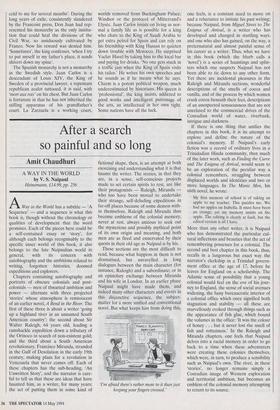After a search so painful and so long
Amit Chaudhuri
A WAY IN THE WORLD by V. S. Naipaul Heinemann, £14.99, pp. 256 AWay in the World has a subtitle — 'A Sequence' — and a sequence is what this book is, though without the chronology or qualities of development that the word promises. Each of the pieces here could be a self-contained essay or 'story', for although each belongs recognisably to the specific inner world of this book, it also belongs to the late Naipaulian world in general, with its concern with autobiography and the ambitions related to writing, forgotten histories, doomed expeditions and explorers.
Chapters containing autobiography and portraits of obscure colonials and post- colonials — men of thwarted ambition and power — alternate with three projected `stories' whose atmosphere is reminiscent of an earlier novel, A Bend in the River. The first of these three is about a writer 'going up a highland river in an unnamed South American country'; the second about Sir Walter Raleigh, 64 years old, leading a ramshackle expedition down a tributary of the Orinoco in search of non-existent gold; and the third about a South American revolutionary, Francisco Miranda, stranded in the Gulf of Desolation in the early 19th century, making plans for a revolution in Venezuela that never comes off. Each of these chapters has the sub-heading, 'An Unwritten Story', and the narrator is care- ful to tell us that these are ideas that have haunted him, as a writer, for many years; the act of putting them in some kind of
fictional shape, then, is an attempt at both exorcising and understanding what it is that haunts the writer. The stories, in that they are, in a sense, self-conscious projects made to set certain spirits to rest, are like their protagonists — Raleigh, Miranda who too have been moved to undertake their strange, self-deluding expeditions in far-off places because of some demon with- in themselves. Raleigh and Miranda thus become emblems of the colonial memory, never at rest, always anxious to seek out the mysterious and possibly mythical point of its own origin and meaning, and both men are as fired and ennervated by their quests in their old age as Naipaul is by his.
These sections are the most difficult to read, because what happens in them is not dramatised, but unravelled in long dialogues between the main character (for instance, Raleigh) and a subordinate; or in an epistolary exchange between Miranda and his wife in London. In an earlier phase Naipaul might have made them, and indeed many other characters and events in this disjunctive sequence, the subject- matter for a more unified and conventional novel. But what keeps him from doing this, Tm afraid there's rather more to it than just keeping your fingers crossed.' one feels, is a constant need to move on and a reluctance to imitate his past writing; because Naipaul, from Miguel Street to The Enigma of Arrival, is a writer who has developed and changed in startling ways, and one who also has gained, on the way, a preternatural and almost painful sense of his career as a writer. Thus, what we have in this book (which the blurb calls a `novel') is a series of hauntings and splin- ters which one suspects Naipaul has not been able to tie down to any other form. Yet there are incidental pleasures in the Raleigh and Miranda sections, wonderful descriptions of the smells of cocoa and vanilla, and of the process by which women crush cocoa beneath their feet, descriptions of an unexpected sensuousness that are not unrelated to the commercial drives of the Conradian world of water, riverbank, intrigue and darkness.
If there is one thing that unifies the chapters in this book, it is its attempt to explore and define the nature of the colonial's memory. If Naipaul's early fiction was a record of ordinary lives in a Trinidadian Hindu community, then much of the later work, such as Finding the Curve and The Enigma of Arrival, would seem to be an exploration of the peculiar way a colonial remembers, struggling between displaced worlds and identities and two or more languages. In The Mimic Men, his sixth novel, he wrote: My first memory of school is of taking an apple to my teacher. This puzzles me. We had no apples on Isabella. It must have been an orange; yet my memory insists on the apple. The editing is clearly at fault, but the edited version is all I have.
More than any other writer, it is Naipaul who has demonstrated the particular cul- tural inflections and beauties that the act of remembering possesses for a colonial. The second and best chapter in this book, thus, recalls in a langorous but exact way the narrator's clerkship in a Trinidad govern- ment office at the age of 17, before he leaves for England on a scholarship. The Adamic sense of possibility that a young colonial would feel on the eve of his jour- ney to England, the sense of social avenues widening, the fussy bureaucratic interior of a colonial office which once signified both stagnation and stability — all these are marvellously evoked through things such as the appearance of fish glue, which bound the volumes in the office: 'It was the colour of honey . but it never lost the smell of fish and rottenness.' In the Raleigh and Miranda chapters, one feels that Naipaul delves into a racial memory in order to go back to a time when these adventurers were creating these colonies themselves, which were, in turn, to produce a sensibility such as Naipaul's own. The river, in these `stories', no longer remains simply a Conradian image of Western exploration and territorial ambition, but becomes an emblem of the colonial memory attempting to return to its source.


























































 Previous page
Previous page